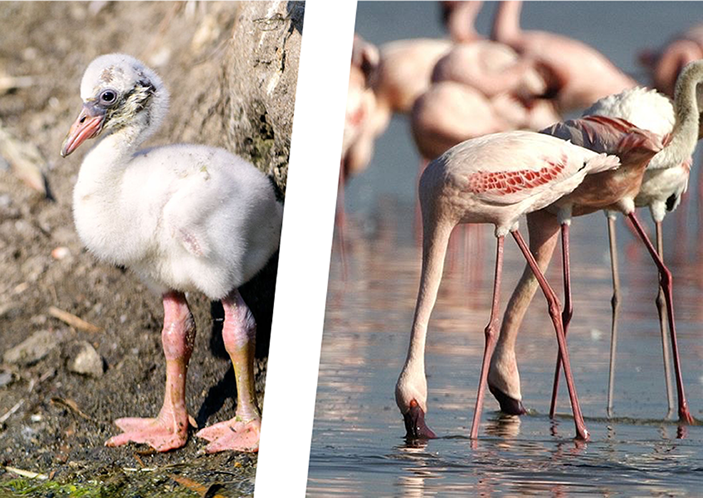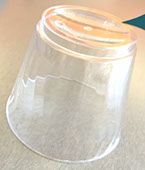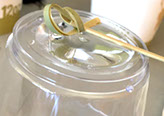Flamingos in a Fix
RETIRED BETA VERSION - For current versions of the SciGen materials, please visit serpmedia.org/scigen
IN THE LAB: The Dangers of Drying Salt

The photos above are of a flamingo chick and some full-grown lesser flamingos.
![]() Why do you think flamingo chicks are more likely to be threatened by salt crystal buildup on their legs as compared to adult flamingos?
Why do you think flamingo chicks are more likely to be threatened by salt crystal buildup on their legs as compared to adult flamingos?
 Observing the rapid crystallization of a saltwater solution
Observing the rapid crystallization of a saltwater solution
Click here if your teacher has assigned you this lab. (Google Doc)
 Some cups have a shallow concave space here that will work well for this lab.
Some cups have a shallow concave space here that will work well for this lab.
Materials (one per student or group)
- Epsom salt
- Boiling water
- Heat-resistant container (such as a paper coffee cup)
- Small clear plastic cup that provides a shallow well when inverted (see photo, right)
- Small stir stick
- Pipe cleaners (or similar) to represent baby flamingo feet
 This student used a small bamboo stirring stick instead of a pipe cleaner.
This student used a small bamboo stirring stick instead of a pipe cleaner.
Caution!
- This lab uses hot liquids.
- Follow your class safety rules.
- Wear goggles.
- Wash hands thoroughly after lab.
Procedure
- Create a small structure made from pipe cleaners (or something similar) that will simulate a "flamingo foot".
- In a heat-resistant container, stir together equal parts Epsom salt and boiling water. Continue stirring until solution is clear.
- Carefully add a small amount of the hot solution into the shallow well of an inverted cup.
- Place the "flamingo foot" on top of the inverted cup so they are partially submerged in the solution.
- Note the time. Leave the "flamingo foot" in this position for several hours.
- Observe the effect after a few hours or the next day.
Observations
Summarize your findings. Develop a hypothesis about how you could design an experiment that would have changed the outcome of this simulation.
What would happen if you dipped the "flamingo foot" in fresh water periodically?
Do you see any connections to the need for fresh water at Lake Natron?
DRAFT© SERP 2016
This Science Generation unit is currently in development. If you have comments or corrections, SERP would love to hear from you! Thank you.